I’ve been steadily plying the needle each day for at least 20 or so minutes on my “Stitch Fun 2021″ sampler – a completely random, no-rules (except a few), year-long stitching exercise.
Through the first weeks of January, I had some frustrating moments which I chalk up mainly to the set-up of this piece. The linen I’m using for it is quite a narrow strip – under 8″ wide, just under a 6” wide stitching width. I really should have planned better, but I was using a strip of fabric I already had cut and it seemed a good way to use it up.
If you’ve ever stitched on a piece of fabric that’s really too small, you know it can be frustrating. If you’re trying to use a hoop, you have to use one that’s smaller than you’d like, so you have to move it around on the embroidery – and that takes time and its own level of annoyance.
If you just barely fit the stitching area into a barely-fitting hoop, it makes for uncomfortable stitching. Everything feels cramped! You don’t have enough fabric on the sides to make adjustments in the hoop easily. And as you approach the perimeter of your stitching, which is being rudely encroached upon by your too-small hoop, you have to … uh… jump through hoops to get your needle in and out of the fabric on the very edge. And then don’t even mention having to turn the work over and fight with ending the thread for stitches crammed right up against the edge of the hoop! What a pain in the …!
Yes! You get the idea!
I decided to solve the problem on my SF2021 sampler once and for all, and then I ditched the hoop and substituted another solution altogether. This is how I solved my cramped-hoop problem – and this is how you can solve similar problems, when you need to make your fabric bigger, to fit a hoop or frame more comfortably.
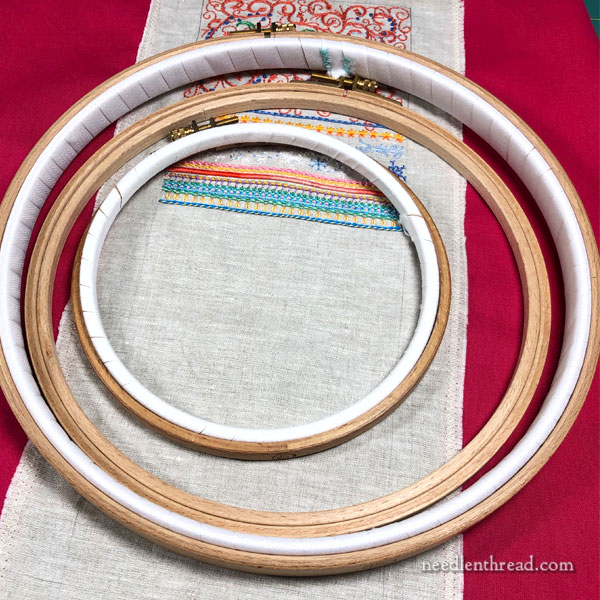
First, I went into my fabric bin and retrieved a few pieces of cotton that I knew were large enough for my purposes. I decided on the color that I was least likely to ever actually use again, and dragged it out and ironed it.
To extend ground fabric so that it fits comfortably in a hoop or frame, you can use any scrap fabric you have that has a firm weave and will hold up to being hooped or framed without a lot of distortion. I would say stick to an inexpensive cotton (muslin, calico, or what-have-you). It can be a print or solid – it doesn’t really matter. Use whatever you have on hand, or whatever you can acquire least expensively, because the fabric is not going to figure in the finish of the piece, and when you’re finished, it will be finished, too!
You can see in the photo above that I picked a very deep hot pink / magenta cotton, and you can see that the hoops are all pretty much too big for just the linen strip!
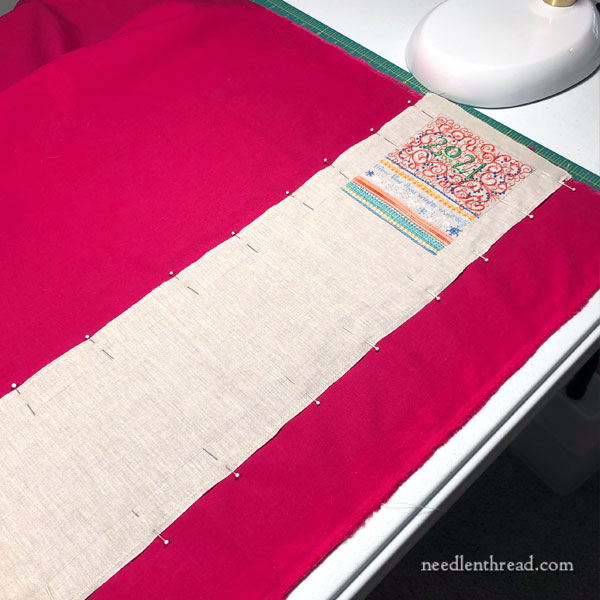
I lightly pressed the sampler strip because it was pretty wrinkled, and then I laid it face up on top of the cotton
I made sure the linen was aligned with the grain of the fabric. If you don’t know what that means, you can read about fabric grain here. Essentially, I wanted the cotton to be straight, and the linen to be straight on top of the cotton.
I pinned the linen to the cotton on both sides down the strip, as shown above.
Then I took it to my sewing machine and zig-zag stitched up the sides of the linen with the linen face-up, so I could see clearly where I was going. The zig-zag was just within the edge of the linen.
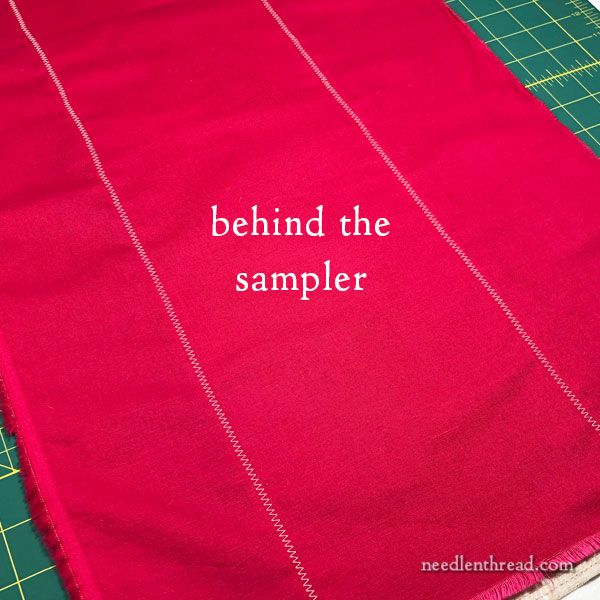
This is the back of the cotton. You can see the zig-zag stitching. It isn’t perfect. It doesn’t have to be.
The area between the two lines is where the linen strip is affixed to the front.
Don’t worry! I’m not planning on stitching the rest of the sampler through both layers!
I took a pair of scissors and carefully cut away the cotton fabric behind the sampler. I cut close to the zig-zag stitching, but not into it, and I was very careful not to snag the linen with my sheers.
If you’re using sheers and you slide them between the linen and the cotton, you don’t really have to worry that you’re cutting the linen, because your scissors are only going to cut what’s between the blades – and the linen is not between the blades! But you might have to be careful that you don’t pierce the linen with the tips of your sheers. Just go slowly and cut on up the line.
Cut off any excess cotton that you won’t need. Your cotton doesn’t have to be huge – it just has to be big enough to comfortably hold the hoop you want to use.
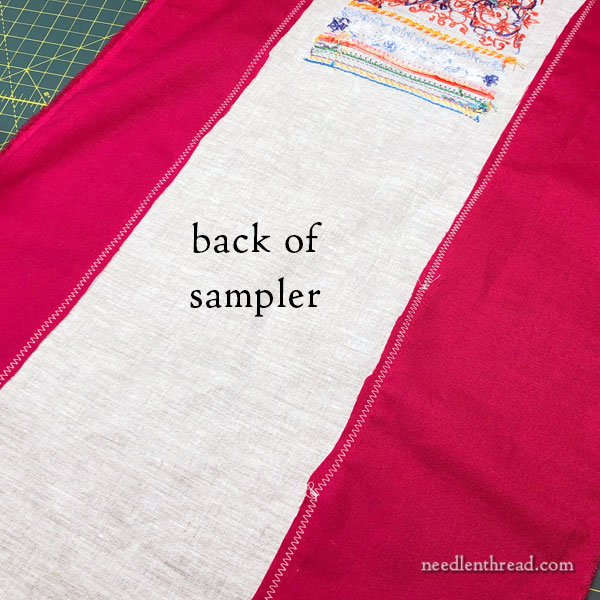
Here, you can see the back of the sampler and the area where the cotton is cut away. It’s not a beautiful cut. It doesn’t matter! Now I have room!
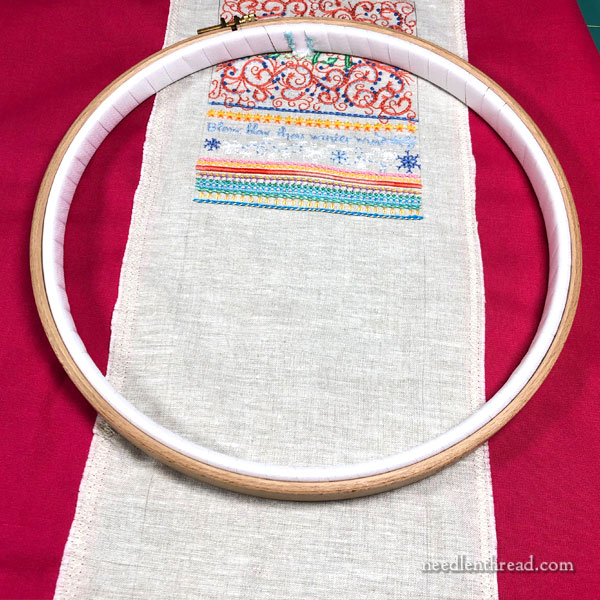
As you can see, a larger hoop fits nice and comfortably over the stitching area of my sampler.
Even though it gives me a lot of room, that hoop is really too large for me to comfortable stitch with frequently, especially if I’m not using a stand to hold the hoop. But if I use a smaller hoop – which will still fit much more comfortably than it did – the rounded sides cut off the stitching area more frequently.
I got it into my head that would be nicer (since the sampler is straight-sided) if my hoop were actually square and not round. It would give me more stitching room in one go, without having to move the hoop to a new area as frequently.
I don’t have a larger square hoop. They do make them, but they are more expensive than round hoops, and unless they are very good quality, they don’t work.
(NB: Plastic square hoops never work. Just so you know! How do I know? I have tried several different attempts at them by different companies. And they never work. They can’t can’t hold the fabric taut.)
But the Hardwicke Manor square hoops are better – they do work. If you’re looking for them, you might try Needle in a Haystack.
In any case, I figured I’d give some q-snaps a try. They’re square.
Now, I don’t use q-snaps often. I know there are stitchers who positively swear by them, but I’ve never cottoned to them myself, so they’re not a go-to thing for me. But I can see how they would be very useful in certain circumstances, and I figured this was one of those circumstances.
I happen to have an 8″ q-snap. I thought I’d give it a try.
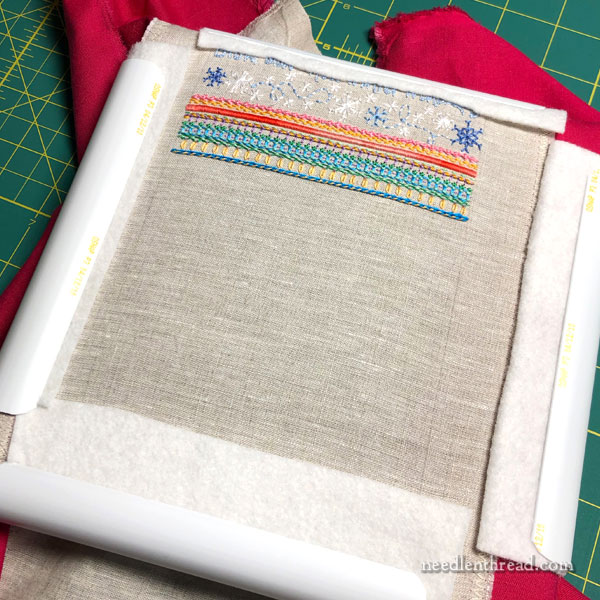
So I did give it a try. And it exposes just the right-sized area for stitching on this sampler!
Hey hey! Happy day!
But… there are a few considerations to using q-snaps for this.
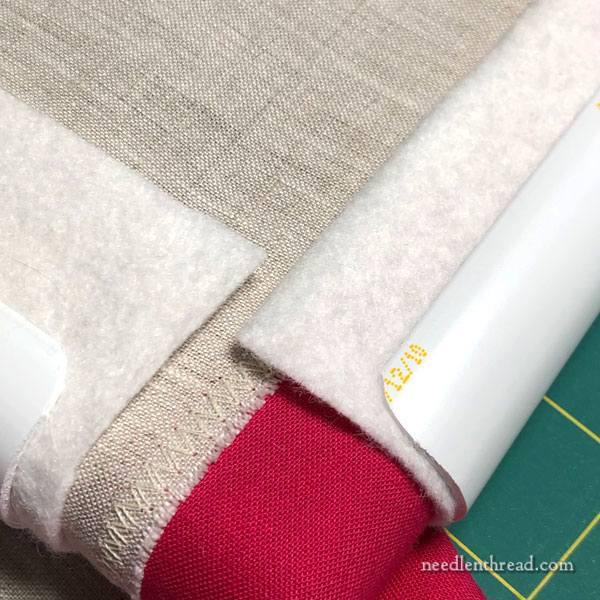
Q-snaps on their own don’t hold the fabric taut enough. The fabric bows and gives too easily, requiring a constant tightening and rolling of the snaps on all the sides.
To solve this, I put a wide strip of felt over the fabric and under each snap. Now the fabric doesn’t budge and the snaps don’t roll.
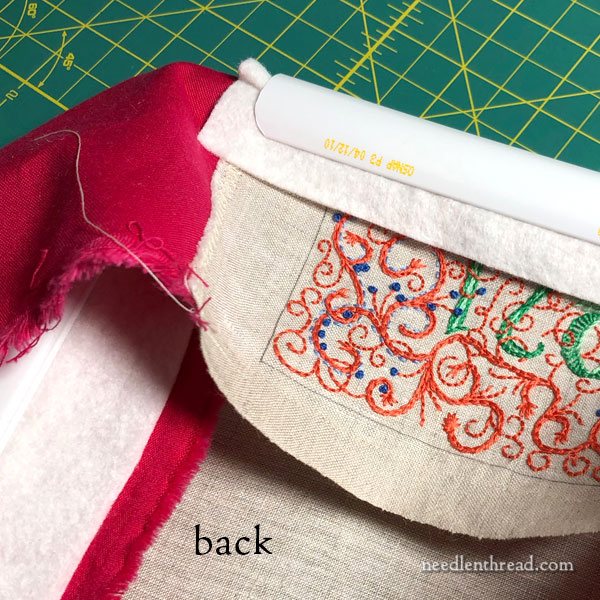
Q-snaps tend to direct the fabric on the back of the work towards the center of the frame. If you don’t have enough fabric there for it to “flow” outwards easily again, the edges of the fabric are always going to be turned in towards the center of your stitching area, unless you have something to solve the problem.
I think they make elasticized fabric “caps” you can put over the q-snaps to hold your excess fabric out of the way. But I rarely use q-snaps, so I didn’t have anything like that.
And I wasn’t going to take the time to make something.
But wait…
Oh yes!
Huggers!
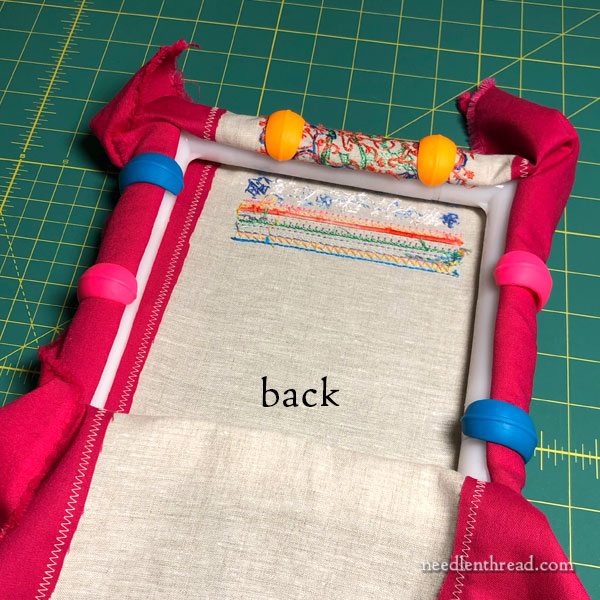
I swear, these things are darned handy for the embroiderer. The first time I saw spool huggers (which I wrote about here, if you want to learn more about them), I thought they were somewhat strangely superfluous to the world of stitching and surely a gimmick.
What is the point? Spools, after all, usually have a place to catch the thread end, already built in. Why would a spool need a hugger? But I bought some anyway, because I had other ideas.
Secretly, between you and me, I think these things were born to be used with q-snaps and embroidery hoops.
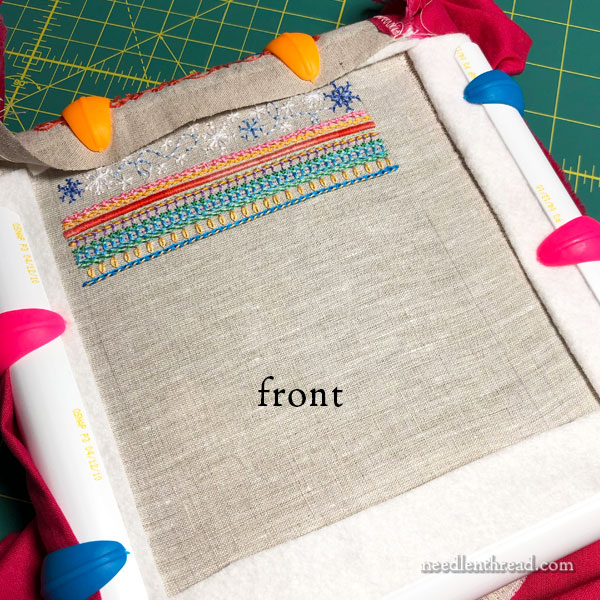
They hold the excess fabric back quite well!
Hey, hey! Happy day!
(Twice! It was a really good day!)
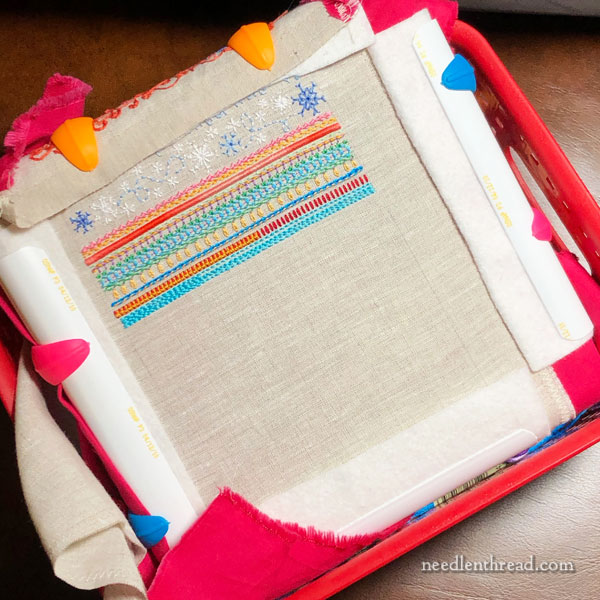
The q-snapped sampler doesn’t fit perhaps as neatly into my little sampler project tub – the hoop and fabric nestled in there on top of the threads so comfortably – but that’s ok!
This works so much better! I spend a lot less time fiddling with fabric and hoop and just stitching. And it’s much more comfortable all around, not to be so crowded on that skinny strip of fabric.
Getting all of this adjusted and my fabric shortage solved was quite satisfying.
And now, if you’re ever stuck with too-small fabric for a stitching project, and you’re struggling with hoop placement and thread-ending-irritations, you know how to solve the problem, too.
Have a swell Monday!
If you’re looking for spool huggers, you can find them on my Amazon Recommendations page, under Tools & Accessories. This is an affiliate link, meaning that Needle ‘n Thread receives a small commission for purchases made through this link, without any extra expense to you.







I use qsnaps for projects that are bigger than my largest roller or fixed frames. Just be careful over beads and super dimensional stitches. French and colonial knots seem to cope ok, but spiderweb flowers don’t fare as well.
Did you know that you can put the clips for the Q-Snaps on the top shelf of the dishwasher to tighten them up.
If you want an easy way to align the grain of the “extra” fabric with the grain of the linen, you can use a woven plaid (like gingham) or a woven stripe, and just line up the grain of the linen with that! The gingham is especially useful, because you can line up both vertical and horizontal grainlines!
I used the q-snap frames when I was working on cross stitch projects. I found that if you put a strip of soft rubber shelf liner (used to protect your glassware) between the frame and your fabric, then put the clips on, your fabric stayed nice and tight. I agree, sometimes a square frame just works out better.
Oh, that’s a good idea – I never thought of using the shelf liner. I like the wool felt, because it’s soft enough to pad any stitches that I might have to clip over, but the shelf stuff is a good, sticky idea! I might give that a try!
What a great idea, adding the fabric on each side. I used to have Q snaps, & never liked them either. They slipped & I felt like I spent more time adjusting & trying to tighten them than I did stitching them. In my last move (I have a wanderlust & move way too much), I donated them. Now I’m wishing that I had kept them, but definitely not enough to buy them again!
Thanks for the great idea though, I’ll use the extended fabric idea. Have a great February.
Lynne
Is this also the way to help frame a finished embroidery that has narrow margins?
Yes, it would work for that, as long as the original ground fabric is in the visible part of the frame, and not the extension fabric.
Thanks a ton for the great tips!! No longer shall I have awkward borders or hoops partially filled with floppy edges of fabric!
If one has a pair of appliqué scissors (I love those things) then a line can easily be cut up the center with a regular pair of fabric scissors, then cut close to the sewn line with the appliqué scissors. This way there’s less fear of the points of scissors jabbing the fabric that will be embroidered.
Mary, That’s genius! I have been struggling with the issue of often having fabric too small for my hoops for years. Thank you for solving my problem.
Dear Mary
I never used q snaps but I think like you I wouldn’t like them, they’ve never appealed to me after I’ve read several negative comments about them. I like the way you have solved the issue of tightening the fabric brilliant idea and a great tip to use. I love your huggers they seem to be so useful for holding things tightly. Thanks for sharing with us this brilliant tips and technique for holding fabric in place. Now you can stitch to your hearts content knowing the fabric is super tight.
Regards Anita Simmance
Mary, I am so thrilled that you found a use for these dud of the thread holders for machine sewing spools! I bought a HUGE bag of them online when they were new. I have tons of sewing threads and open double, floor to ceiling cabinet 1” deep that showcases them beautifully. The website gave me an option of white or colours. Of course I chose white! Why would you put garish colours on the hundreds of carefully chosen thread spools of colour chosen to see and pick shades to use together?
They sent me these horrid coloured ones. I got an “oops! Sorry, they don’t have white like we thought. But we don’t do returns on sale items.” Even though it was an introductory sale. They prob figured out no one who really took thread color seriously would ever buy them! So I was stuck. And fuming.
I had to hide them as I was so put out not to throw them away.
But NOW THEY HAVE A USE! I love the Q-Snaps but have made some adjustments as well. Silicone between the ridges and on the top of the frames work well but one must reapply often.
Thank you, thank you Mary! And I love this new sampler you are doing. Can’t wait to see how long it gets & hope you use a lot of combined stitches!
Kim
Since you’re only working on this project 20 min per day, do you leave the project in the qsmaps, or still take it out at the end of every session? I’m doing a stitch sampler as my 100 Days of Creativity project, and am not liking the round hoop. I might give snaps a try. Thanks for all the tips!
Well, I’ve been leaving it in! It’s just easier. But I do have a layer of wool felt between the snaps and the frame parts, which helps protect the fabric and previous stitches.
Honey, you never cease to amaze me. Wonderful work.
Thank you Mary, for sharing your QSnap workarounds. I’ve just bought one to try with a counted thread piece I’m doing on 36ct linen. I definitely experienced some of the challenges you described and I’ll bookmark this article to keep coming back to when I’m framing up. I like how light the frame is, the tautness is sufficient for the type of embroidery I’m doing and with some jiggery pokery I worked out how to centre my fabric fairly well, but it not easy keeping the grain of an evenweave fabric straight as it’s clipped into the frame. It tends to shift about a bit. However I love that it’s square (I’m really not a fan of hoops) and the QSnap works brilliantly with my floor standing frame. It feels very serendipitous that you posted an article on the same topic just when I needed it. Thank you!
Finally! I can’t tell you how long I’ve been looking for a way to put too-small fabric in a hoop and haven’t been able to find a single article on the subject. You did a very good job of making the process of extending the fabric easy to understand — thank you!
You refer to ‘sheers’ while telling how to cut. What kind of scissors are these? Or was I misreading the post.
Thank you
I just use my sewing sheers when I’m cutting fabric.
Thanks for the information. I’d never heard scissors called sheers
Best regards
Mary,
If I could put you on CNN for a thank you award for the entire embroidery world I would!
Deeply appreciate you. Jo
LOL. Thanks, Billie Jo! 🙂